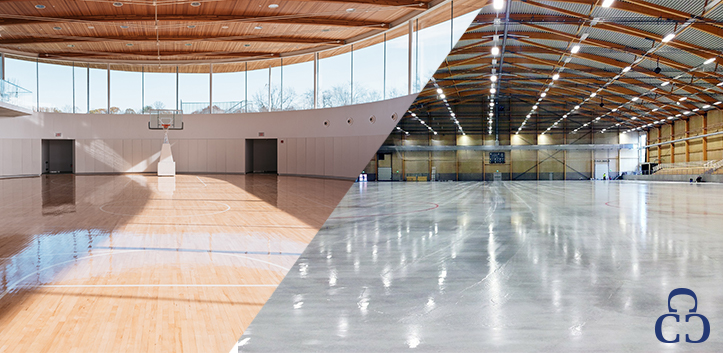
Most people have attended sporting events at an indoor multipurpose arena. Today, many cities host multiple sports teams, which means that having a home court or home ice is important.
All indoor arenas rely on custom concrete floors to support the massive weight demands placed on the surface. These concrete slabs are more than meets the eye, concealing technology that makes multipurpose event hosting possible. Here’s some insight into how your local arena does it.
Initial Installation
Ever wondered how a hockey team can play on a surface one night, followed by a basketball team the next?
It all comes down to two things: a dedicated tear-down and set-up crew, and the concrete technology that’s hidden from view.
Before any concrete is poured, metal piping – sometimes upwards of ten miles’ worth – is laid on the work surface. This will enable the floor to heat, thaw, and freeze itself. Heating prevents the ice surface from freezing the ground below it.The piping must be woven in between the reinforced steel grid that is installed to support the weight of the concrete.
Until recently, Freon™ R-22 refrigerant was used in almost all new installations as a cooling agent to create ice. This is coming to a halt, though: by the year 2020, the agent will not be made or imported into the country under EPA regulations. Many ice rinks that have been using Freon™ for decades must either upgrade now or recycle their existing coolant indefinitely. States littered with ice rinks (such as Minnesota) are considering legislation to help communities redo their rinks.
No matter which refrigerant gas is used, about 7,000 pounds of it are required to effectively freeze an entire rink.
Once this network of pipes and steel reinforcements are laid and covered with sand or insulation, the surface is ready for concrete.
The Pouring Process
Regardless of what they’re used for, it’s crucial that custom concrete floors are level.
In order to achieve this, concrete companies usually pour in multiple floor locations at once. Trucks bring in the huge amounts of raw cement, which is pumped through lengthy hoses onto the surface. Usually, around 40 truckloads of cement are required.
The wet concrete can be layered on anywhere from 6 to 12 inches deep, depending on the weight demands that the finished surface will need to handle.
How large will the entire poured surface be? A standard National Hockey League rink is 200 feet by 85 feet, or about 17,000 square feet. Here’s a time lapse video of a surface that size being poured and cured.
Finishing the Concrete
As mentioned above, the floor must be perfectly level. A system of laser sensors positioned on the sides helps guide “finishing machines” which run over the surface to smooth it. Hand-operated floats are also used by workers to remove any imperfections. Depending on the surface’s uses, one of many custom concrete coatings or sealants may be applied.
When the surface is completely poured and finished, it is allowed to cure under specific temperature conditions. Special covering tarps are employed to protect the concrete while it hardens. The floor typically takes about one month to cure.
Uses for the Surface
The first time the concrete is cooled after curing is a very gradual process. Cooling and icing too quickly can cause shrinking and cracking.
The surface is misted and then slowly covered with water. Once frozen, the ice can be anywhere from about a half-inch to and inch-and-a-half thick for various events or competitions. Some arenas may also use pre-frozen panels of ice that can be more quickly laid and kept cool.
A hardwood surface for basketball can be easily installed. The ice is thawed, broken and removed before any excess seating or equipment is removed. Crews then assemble the hardwood piece-by-piece on top of the bare concrete. See here for a more detailed rundown of the changeover process from North Carolina’s PNC Arena. Alternatively, here’s a time lapse video of a similar changeover process.
This bare, gray concrete surface is sometimes used as a floor for concerts or other events. Floor seating and heavy equipment can sit atop these finished custom concrete floors.
******
Custom Concrete Creations is chosen to help facilitate projects because we are the preferred custom concrete floor company, not only in Omaha, but for the greater Midwest region. No project is too big or too small for our team of seasoned experts who use state-of-the-art equipment on each and every project. We help you achieve the look of your dreams and do not consider the job done until you are happy with the results. So give us a call or contact us for your custom concrete needs today!
